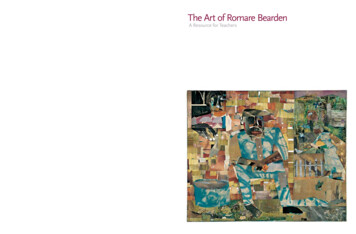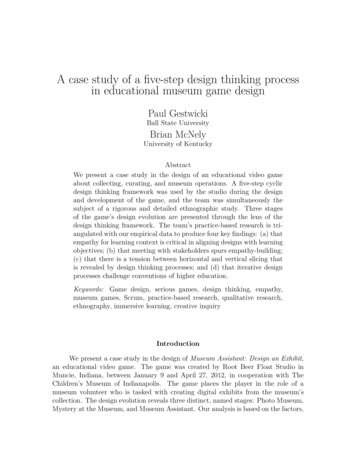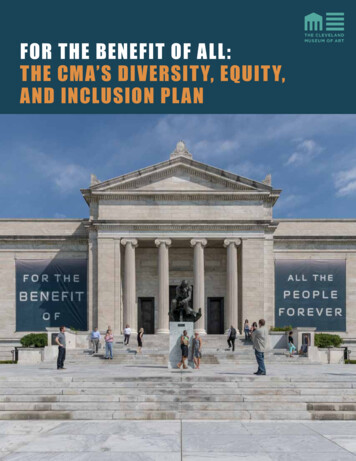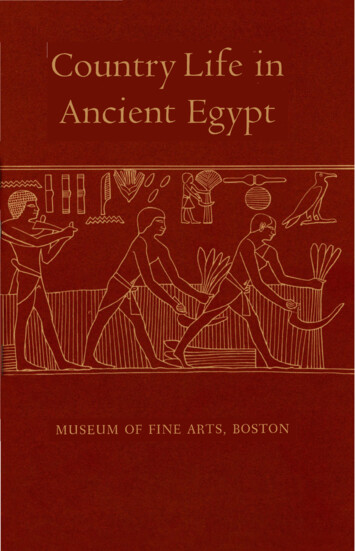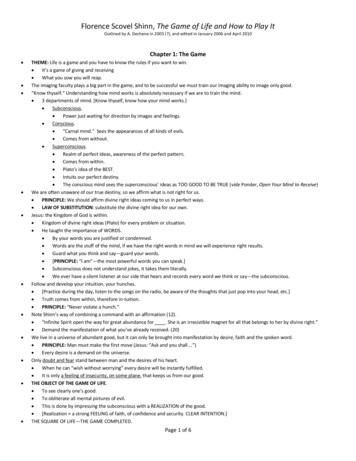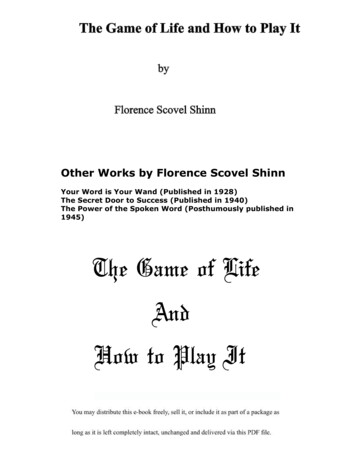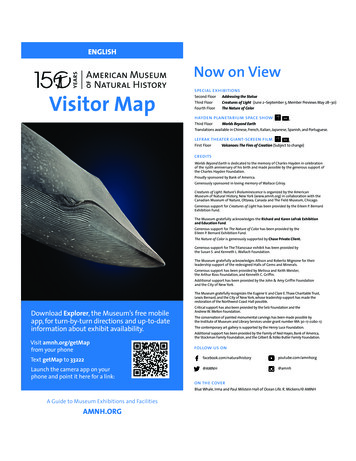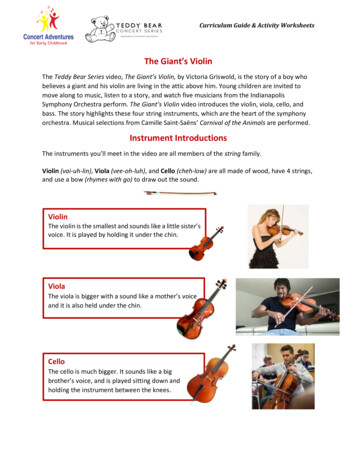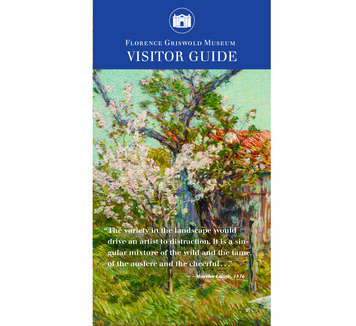
Transcription
VISITOR GUIDE“ The variety in the landscape woulddrive an artist to distraction. It is a singular mixture of the wild and the tame,of the austere and the cheerful . . .”—Martha Lamb, 1876
As you use this guide to explore the Florence Griswold Museum,you will walk the grounds enjoyed by Miss Florence Griswold(1850–1937) and the painters of the Lyme Art Colony who tookup residence in her house beginning in 1899. Experience first-hand theenvironment of one of the largest Impressionist art colonies in America,including the Robert F. Schumann Artists’ Trail. This new addition to theMuseum, opened in 2019, offers an opportunity to take in the natural,artistic, and historic highlights of our site via a half-mile, ADA-accessiblepathway that links the fragments of the original Griswold estate for thefirst time since 1936. Inside this guide, you will find a detailed map withpoints of interest around the Museum and along the trail.F& Nancy Krieble Gallery: Designed by Centerbrook Architects andA Robert opened in 2002, this award-winning gallery houses the admissions desk, changingexhibitions, the Museum’s art and archival collections, a brief orientation film, The Shop,and visitor amenities. A research archive is also available by appointment. The Robert F.Schumann Artists’ Trail starts at the Krieble Gallery’s side entrance.House: To generate money for the elderly Miss Florence’s care, her estateB Marshfield was sold in 1936 to Judge Robert McCurdy Marsh of New York. He built the house asa weekend and summer retreat in 1937, taking advantage of picturesque views of theLieutenant River. Privately owned until 1997, Marshfield is typically closed to the publicbut hosts Museum programs, private rental events, and Café Flo (open May-October).Flo: Enjoy outdoor dining overlooking the Lieutenant River (open May-October).C Café E J ohn & Kelly Bill Hartman Education Center: The hub of hands-on creativeprograms for visitors and school groups. Open to the public on Sundays for art projects,including the opportunity to paint your own canvas indoors or out (open Sundays, AprilDecember).Griswold House: Home of the Lyme Art Colony. A remarkable series ofF Florence paintings on the doors and dining room walls is unique in American art. The house isdesigned to be self-guided, and there are knowledgeable docents inside to providemore information about the period rooms and upstairs galleries.Chadwick Studio: Similar to the studios that once dotted the property,G William William Chadwick’s studio provides a glimpse into the working methods of the Lymeartists. Moved from Chadwick’s home in Old Lyme to this site and opened in 1993, theshingled building combines a painting room lit by a large north window, a storage loft,and a framing workshop (open April-October).& Dyanne Rafal Landscape Center: An exhibition of photographs,D John tools, and videos inside describes Miss Florence’s gardens and the history of the locallandscape (open April-October).AEEACGFBDG
The Robert F. Schumann Artists’ TrailHEDGEROW WALKRIVER WALK1. Farm FieldsThe Griswold family moved to this propertyin 1841 and cultivated the land near theLieutenant River with crops such as corn,oats, potatoes, beans, and hay. During theart colony years, journalists commented onthe fresh produce served at Miss Florence’smeals, harvested from the riversidefields. During breaks from painting in hisstudio (see Woodland Walk), artist WilliamS. Robinson enjoyed cutting hay in thesefields with a scythe.2. Lieutenant River OverlookThis 3.7-mile-long river joins the ConnecticutRiver estuary near Long Island Sound. TheLieutenant River is tidal and brackish, withmarshes along its banks. Its wharves oncesupported shipbuilding and trade of localproduce with the West Indies. The riveralso powered a gristmill, a fulling mill forprocessing cloth, and a nail factory in whichFlorence Griswold’s father invested. Lymeartists depicted the waterway’s picturesquecurves on their canvases. For fun, theypaddled Florence Griswold’s rowboats calledScarlet Fever, Smallpox, and Prickly Heat,launching from a dock whose remains arevisible to the north. Today, fish such as shad,white perch, and striped bass frequent theriver, as do migrating eels and birds. Greategrets, great blue herons, and mute swansare commonly seen in this area, with baldeagles arriving each winter.3. Rainwater Garden withNative PlantsThe banks of the Griswold land along theLieutenant River have hosted a range ofplants over the years, from native mountainlaurel, to white birches, to vegetablescultivated for Florence Griswold’sboardinghouse table. Those disturbancesand changes in the soil’s chemistry allowedinvasive plants to take hold. Indigenousplantings have now been added andinroads made against non-native plantspecies. The varieties chosen can tolerateboth wet and dry conditions and includerushes, irises, sedge, butterfly weed andother plants that support healthy bird andinsect populations. This rainwater gardenoffers major ecological benefits: it collectsand cleans water after a rain to removetoxins before it re-enters the LieutenantRiver and recharges the groundwater,contributing to the river’s health.4. Osprey NestsThis location provides the ideal view ofosprey nests on the riverbank and in themarsh just across the Lieutenant River(resting on elevated platforms). The birdsspend spring and summer in Old Lyme,dining on fish from the river before migratingto South America each September. Ospreyswere threatened in the 20th century bythe pesticide DDT, as field-guide authorRoger Tory Peterson observed from hishome upriver from the Museum. Like hisfriend Rachel Carson, writer of the landmarkenvironmental conservation book SilentSpring, Peterson helped bring awareness tothe issue, saving the birds.5. Bow BridgeArtists set up easels near where you nowstand as a vantage point for paintingthe Bow Bridge, which once crossed theLieutenant River near the present-day bridgevisible to the southwest. The quaint, woodenarched structure was one of the Lyme artists’favorite subjects. Lyme Art Colony founderHenry Ward Ranger chose the bridge asthe subject for his painting on one of thedoors in Florence Griswold’s house. Theoriginal bridge was built around 1830 andlater raised to allow for the passage of boatsfilled with salt hay from the marshes. It wasreplaced with an iron structure in 1914 whencar traffic from a new highway bridge overthe Connecticut River proved too muchof a strain, and again in 1928 with a steelbridge. The footings of the Bow Bridgeare still visible on the far bank. The spotwhere you are standing is on property theMuseum acquired in 2016 to reestablish theboundaries of Florence Griswold’s originalestate. As our landscape restoration alongthe Lieutenant River progresses, this vistawill eventually include a meadow with nativeflowers and grasses.6. Childe Hassam’s Studio SiteFlorence Griswold encouraged her artistboarders to use her farm sheds as studios,at least seven of which dotted the estate. A1998 archaeological dig and evidence frompaintings and historic photographs show thatImpressionist Childe Hassam’s studio washere at the northwest corner of the orchard.During spring visits, he stepped outside itto paint the flowering apple trees (see hisdepiction of the studio on the front of thisguide). Although the original studio is gone,its shape has been outlined in granite carvedwith Hassam’s crest. As you walk aroundit, imagine a rustic room with the smell ofturpentine and wet paint, mixed with thescent of fresh grass and apple blossoms.Uneven plank walls and a metal roof wouldhave transmitted the sun’s warmth and thesound of raindrops, as well as the voices offellow painters stopping by. Hassam kept apipe in a drawer of the room’s small table andlounged on a sofa he snuck out of anotherartist’s studio, only to have it disappear whenthe prank was returned. When reserving aguestroom, Hassam requested this studiofrom Miss Florence, but when he wasaway other artists moved in to enjoy itsadvantageous location and river views.7. OrchardThe Griswold family cultivated fruit trees afterthey bought the property in 1841. By 1880,one acre of the estate was devoted to anorchard consisting of 40 trees. Historically,varieties included plum, peach, cherry, andapple, and the orchard now hosts heirloomapple trees as well as crabapple, pear, cherry,and plum cultivars. Lyme Art Colony paintersset up easels in the orchard, which was a sitefor outdoor leisure as well as agriculture.Miss Florence sought to manage the orchardwell, allowing its use in spraying and pruningdemonstrations by the New London CountyFarm Bureau.8. HedgerowDating to medieval England, hedgerowswere planted around fields to serve asnatural fences, windbreaks, and erosioncontrol. In New England, they have oftengrown up around the remnants of old stonewalls. Located at the edges of a property,hedegrows are a rich ecosystem thatattracts birds, insects, and mammals, sorestoring those areas of our site improvesits environmental health. Trees, bushes,and plants of different heights are denselyclustered to offer shelter, nest sites, and foodto animals, birds, and insects, many of themvital pollinators. Along this old lane, someinvasive plant species have been removedand native shrubs and plants added to attractwildlife, insects, and songbirds. Nestingboxes and bat houses have been placed tomake them feel at home. During the yearsof the Lyme Art Colony, the lawn betweenthis path and the Florence Griswold Housefeatured lush vegetation, including what a1904 newspaper described as “delightfulwalks among old fashioned flowers andshrubs” such as bowers of lilacs.9. Florence Griswold Houseand LawnConsidered one of the finest examples ofLate-Georgian architecture in America, theFlorence Griswold House was built in 1817for the Noyes family by the architect SamuelBelcher. Upon marriage, Florence Griswold’sfather bought the home in 1841. Thebuilding’s historic character and picturesquegrounds captured the imagination of artistswhen it served as the boardinghouse forthe art colony beginning in 1899. Don’t missseeing the remarkable paintings the artistsleft on the walls and doors on the house’sfirst floor. During breaks from their work, theartists sprawled on the front porch and lawn,talking and playing games of baseball orhorseshoes that continued on the grass tothe south side of the house. Please enter thehouse from the back porch.
WOODLAND WALK352410. Woods and UnderstoryLocated at the edge of what was once afield, this area of Florence Griswold’s originalproperty was historically more overgrown,with tangled vegetation and native plantslike laurel that enjoy the shade of theunderstory, where they are shielded by acanopy of taller trees. Today, evergreen firs,rhododendron, and holly, as well as witchhazel and winterberry have replaced some ofthe invasive plants that had made their wayinto this area. Ferns and woodland flowerscover the ground, restoring the grove as ahabitat for owls, ducks, and other birds alongthe nearby stream.1BC7G1415D11. Bridge to Lyme Art Associationand Mile BrookSteps here lead to a path and bridge thatconnect to the Lyme Art Association (LAA).Florence Griswold sold a portion of herproperty to the LAA in 1917 so the artistscould construct a permanent gallery toexhibit their work. Designed by architectCharles Platt, it opened in 1921 with MissFlorence as manager. Mile Brook begins tothe northeast at the Boggy Hole Swamp.It passes behind the LAA, where it oncebroadened into an ice pond for the Griswoldfamily (now largely filled in). What remains ofthe brook resurfaces beyond the interstatehighway, where it flows into the LieutenantRiver.12. Pump HouseThe concrete structure set into the groundonce sheltered a mechanical pump thatmoved water from the Mile Brook up toFlorence Griswold’s house. Thank you for notwalking on the pump house.13. Former Robinson Studio SiteIn the 1930s, Lyme Art Colony painter WilliamS. Robinson leased a studio from FlorenceGriswold that once stood near the end ofthis trail. The ramshackle building existeduntil the 1980s. From this spot, Robinsoncontemplated the beauty of the woodedstream, which once formed a pond behindthe LAA known as Florence Pool. To extendthe view, the Museum plans to continuerestoring this landscape. To visit a similarstudio used by Impressionist painter WilliamChadwick, follow the trail toward signs for theChadwick Studio (seasonal) as you return tothe Krieble Gallery.6A168EF91110GARDEN WALK14. Benjamin Eggleston PortableStudio and Art CartArtists came to Old Lyme to paint outdoors,and several used portable studios to help themdo so in cold or wet weather. This cart wasrecreated from a photograph of artist BenjaminEggleston’s portable studio, which he couldpull to his desired painting spot. Inside, thereare kits with hands-on art and nature activitiesfor all ages (open April-November).15. Miss Florence’s GardensLike her mother before her, Miss Florencewas an avid gardener. She ordered flowersand vegetable seeds from catalogues lateeach winter and nurtured old-fashionedperennials. Behind her house there were fourdistinct gardens: one for herbs and producesuch as strawberries, lettuce, peas, corn,and potatoes; one for roses; and two forflowers, which she also sold to make endsmeet. Using historic photographs, films,and paintings, these gardens have beenre-planted and the white rose trellis re-builtto reflect how they appeared to the artists ofthe colony, who made the gardens a majorsubject of their paintings. Pick up a gardenguide at the front desk or Landscape Centerto help identify many of the plant species.16. John & Dyanne RafalLandscape CenterBuilt in 1851, this barn is original to theproperty and was restored in 2009. It oncehoused the Griswold family’s pigs and dairycows. Today, an exhibition of photographs,tools, and videos inside describes the locallandscape’s history and uses up through theLyme Art Colony period. In the hayloft, youwill see the canoe brought to Old Lyme byfuture president Woodrow Wilson and hisfamily for paddles on the Lieutenant Riverduring their summer visits to the art colony(open April-October).Continue on to the Florence GriswoldHouse or visit the special exhibitionin the Krieble Gallery.
(Left) Florence Griswold in her garden, ca. 1910. (Above) John R. Baynes, Jr., TheHot Air Club, ca. 1906. Lyme Historical Society Archives, Florence Griswold MuseumWho Was Miss Florence?By the late 1890s, the Museum’s namesake Florence Griswold (1850–1937) was nearly fifty yearsold. The youngest child of a once-prosperous sea captain, she outlived her parents and all butone of her three siblings, and faced the future as an unmarried woman with few economicprospects. She inherited the family home along with the costs of its upkeep. To survive, she choseto take in boarders, a common and socially acceptable occupation for women at the time. Fortunately, during the summer of 1899, one of her visitors was Henry Ward Ranger, an Americanartist looking to establish an art colony in New England. He returned with a group of artists thefollowing year and over the next two decades the Florence Griswold House in Old Lyme was thecenter of a thriving artist colony.Thank you for visiting us today!The Robert F. Schumann Artists’ Trail was made possible throughthe generosity of the Robert F. Schumann FoundationPublication of the Visitor Guideis sponsored in part by the Chelsea Groton FoundationFollow us onFlorenceGriswoldMuseum.orgFront cover image:Childe Hassam , Apple Trees in Bloom, Old Lyme (detail), 1904. Oil on wood, 25 x 30 in. Giftof the Vincent Dowling Family Foundation in Honor of Director Emeritus Jeffrey Andersen
toxins before it re-enters the Lieutenant River and recharges the groundwater, contributing to the river’s health. 4. Osprey Nests . This location provides the ideal view of osprey nests on the riverbank and in the marsh just across the Lieutenant River (resting on elevated p
